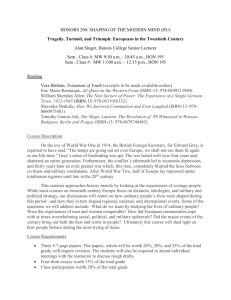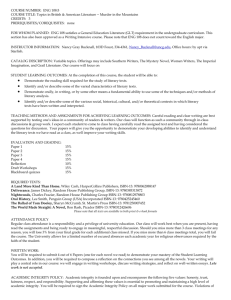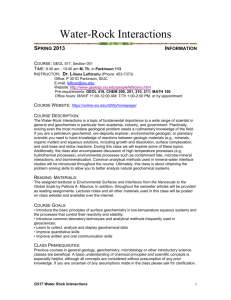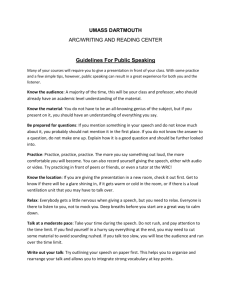Science Pacing Guide
advertisement
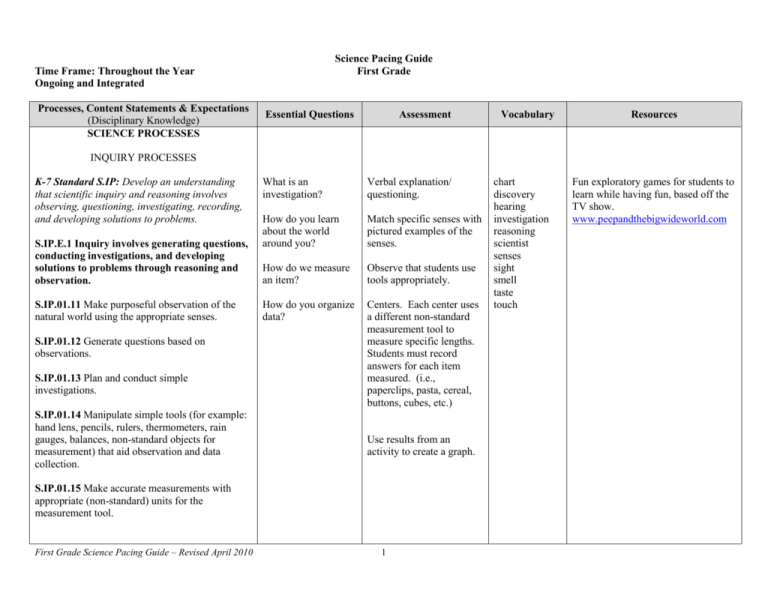
Science Pacing Guide First Grade Time Frame: Throughout the Year Ongoing and Integrated Processes, Content Statements & Expectations (Disciplinary Knowledge) SCIENCE PROCESSES Essential Questions Assessment Vocabulary Resources INQUIRY PROCESSES K-7 Standard S.IP: Develop an understanding that scientific inquiry and reasoning involves observing, questioning, investigating, recording, and developing solutions to problems. S.IP.E.1 Inquiry involves generating questions, conducting investigations, and developing solutions to problems through reasoning and observation. S.IP.01.11 Make purposeful observation of the natural world using the appropriate senses. S.IP.01.12 Generate questions based on observations. S.IP.01.13 Plan and conduct simple investigations. S.IP.01.14 Manipulate simple tools (for example: hand lens, pencils, rulers, thermometers, rain gauges, balances, non-standard objects for measurement) that aid observation and data collection. What is an investigation? Verbal explanation/ questioning. How do you learn about the world around you? Match specific senses with pictured examples of the senses. How do we measure an item? Observe that students use tools appropriately. How do you organize data? Centers. Each center uses a different non-standard measurement tool to measure specific lengths. Students must record answers for each item measured. (i.e., paperclips, pasta, cereal, buttons, cubes, etc.) Use results from an activity to create a graph. S.IP.01.15 Make accurate measurements with appropriate (non-standard) units for the measurement tool. First Grade Science Pacing Guide – Revised April 2010 1 chart discovery hearing investigation reasoning scientist senses sight smell taste touch Fun exploratory games for students to learn while having fun, based off the TV show. www.peepandthebigwideworld.com Processes, Content Statements & Expectations (Disciplinary Knowledge) S.IP.01.16 Construct simple charts from data and observations. Essential Questions Assessment S.IA.E.1 Inquiry includes an analysis and presentation of findings that lead to future questions, research, and investigations. S.IA.01.12 Share ideas about science through purposeful conversation. S.IA.01.13 Communicate and present findings of observations. S.IA.01.14 Develop strategies for information gathering (ask an expert, use a book, make observations, conduct simple investigations, and watch a video). S.RS.E.1 Reflecting on knowledge is the application of scientific knowledge to new and different situations. Reflecting on knowledge requires careful analysis of evidence that guides decision-making and the application of science throughout history. S.RS.01.11 Demonstrate scientific concepts through various illustrations, performances, models, exhibits, and activities. S.RS.01.12 Recognize that science investigations are done more than one time. First Grade Science Pacing Guide – Revised April 2010 2 Vocabulary Resources Time Frame: September – October Unit 1: Beginnings (State Unit 3 – Weather) Processes, Content Statements & Expectations (Disciplinary Knowledge) Science Pacing Guide First Grade Essential Questions K-7 Standard E.ES: Develop an understanding of the warming of the Earth by the sun as the major source of energy for phenomenon on Earth and how the sun’s warming relates to weather, climate, seasons, and the water cycle. Understand how human interaction and use of natural resources affects the environment. How does the weather change with the seasons? E.ES.E.2 Weather – Weather changes from day to day and over the seasons. What are different types of weather? E.ES.01.21 Compare daily changes in the weather related to temperature (cold, hot, warm, cool); cloud cover (clear, cloudy, partly cloudy, foggy) precipitation (rain, snow, hail, freezing rain); wind (breezy, windy, calm). How do people adapt to weather changes? E.ES.01.22 Describe and compare weather related to the four seasons in terms of temperature, cloud cover, precipitation, and wind. E.ES.01.23 Describe severe weather characteristics. E.ES.01.24 Describe precautions that should be taken for human safety during severe weather conditions (thunder and lightning, tornadoes, strong winds, heavy precipitation). First Grade Science Pacing Guide – Revised April 2010 How do we measure changes in weather? What are some characteristics of these severe weather conditions: thunderstorms, lightning, tornadoes, high winds, and blizzards? What should be done in each of the severe weather conditions (thunderstorms, tornadoes, and blizzards)? Assessment Make a season diagram: Students create a four-fold paper chart illustrating the weather conditions in each of four seasons. Compare the seasons in terms of temperature, cloud cover, precipitation and wind. Activity: Set up a weather station in the classroom, like meteorologists, students will make and record weather observations over time. 3 Vocabulary temperature cold warm hot cool weather conditions daily weather pattern cloud clear-sunny cloudy partly cloudy foggy precipitation rain snow hail freezing rain rain gauge wind sock wind vane breezy windy calm solar percentage centimeters inches north south east west Resources Books: Air is All Around You, Franklyn M. Branley, 2006. ISBN-13: 978-0060594152 The Wind Blew, Pat Hutchins, 1993. ISBN-13: 978-0689717444 Activity: Take the class outside to make weather observations using their senses. Engage the students in a talk about what the weather is like today, and what it was like yesterday. Ask them how scientists know what the weather will be like tomorrow. Thunder Cake, Patricia Polacco, 1990. ISBN-13: 978-0698115811 Engage students in a discussion about seasons, the appropriate clothing, and activities they can do during each season. Weather safety quizzes, tornadoes, thunderstorms and blizzards http://tinyurl.com/azsh5e Processes, Content Statements & Expectations (Disciplinary Knowledge) E.ES.E.3 Weather Measurement – Scientists use tools for observing, recording, and predicting weather changes. Essential Questions E.ES.01.31 Identify the tools that might be used to How are measure temperature, precipitation, cloud cover thermometers, rain and wind. gauges, and wind vanes used to E.ES.01.32 Observe and collect data of weather measure the weather conditions over a period of time. conditions? Assessment Activity: Give students opportunities to practice using thermometers. Let them take temperature measurements of various temperatures of water, snow, outdoors in sand/soil, etc… Lay a transparent hundred square on top of pictures of clouds. Count or estimate the number of squares that have a part of the cloud in them to determine the percentage of cloud cover. Vocabulary Celsius Fahrenheit Severe weather Thunderstorm Lightning Tornadoes Blizzards Breezy Wind Strong winds Safety Cloud cover Sunny Precautions Resources Book: Little Cloud, Eric Carle, 2001. ISBN-13: 978-0698118300 NOAA mascot and information http://noaa.kids.us/owlie.htm Activity: Set up a table or center with weather instruments, including thermometers, rain gauges and pictures of rain gauges, wind vanes, wind socks, and weather events. Give students opportunities to explore and ask questions. As a class watch a weather forecast on television or look at one on the Internet. State Companion Document for ideas on inquiry/ instructional strategies for each unit. http://tinyurl.com/cswnaj First Grade Science Pacing Guide – Revised April 2010 4 Time Frame: November – January Unit 2: Growth (State Unit 2 – Animal Life) Processes, Content Statements & Expectations (Disciplinary Knowledge) K-7 Standard L.OL: Develop an understanding that plants and animals (including humans) have basic requirements for maintaining life which include the need for air, water and a source of energy. Understand that all life forms can be classified as producers, consumers, or decomposers as they are all part of a global food chain where food/energy is supplied by plants which need light to produce food/energy. Develop an understanding that plants and animals can be classified by observable traits and physical characteristics. Understand that all living organisms are composed of cells and they exhibit cell growth and division. Understand that all plants and animals have a definite life cycle, body parts, and systems to perform specific life functions. L.OL.E.1 Life Requirements – Organisms have basic needs. Animals and plants need air, water, and food. Plants also require light. Plants and animals use food as a source of energy and as a source of building material for growth and repair. Science Pacing Guide First Grade Essential Questions Have students identify the needs of living things using evidence. Web map the basic needs of plants/animals. What are the basic needs of living things? What do animals need to stay alive? L.OL.01.13 Identify the needs of animals. L.OL.E.2 Life Cycles – Plants and animals have life cycles. Both plants and animals begin life and develop into adults, reproduce, and eventually die. The details of this life cycle are different for different organisms. L.OL.01.21 Describe the life cycle of animals including the following stages: egg, young, adult; egg, larva, pupa, adult. First Grade Science Pacing Guide – Revised April 2010 Assessment What stages do animals go through in their life cycle? What stages do some animals such as the butterfly go through? Create a life cycle sequencing mat. (Arrange pictures in sequence.) Observe the stages of development in live butterflies; create a book diagramming the sequence of development. Read a lifecycle book about an animal, and ask the students How do animals change? Then lead a discussion on what stages of growth the animal experienced. 5 Vocabulary needs of animals life cycle egg young adult larva pupa characteristics parents air water food beak shape body coverings: fur feathers skin hair scales inherited metamorphosis insects butterfly moth chrysalis cocoon eye color animal features basic needs behavior patterns death growth Resources Books: Under One Rock: Bugs, Slugs and other Ughs, Anthony Fredericks, 2001.ISBN-13: 978-1584690276 An Earthworm’s Life, John Himmelman, 2000. ISBN-13: 978-0516265353 (You can also find other animals in the series: dandelion, house spider, hummingbird, ladybug, slug, wood frog, etc…) Processes, Content Statements & Expectations (Disciplinary Knowledge) K-7 Standard L.HE: Develop an understanding that all life forms must reproduce to survive. Understand that characteristics of mature plants and animals may be inherited or acquired and that only inherited traits are passed on to their young. Understand that inherited traits can be influenced by changes in the environment and by genetics. L.HE.E.1 Observable Characteristics – Plants and animals share many, but not all, characteristics of their parents. Essential Questions How characteristics are passed on from parents to their young? Match pictures of adult animals with offspring. Can you match these baby animals with their parents? Resources Books: In the Woods: Who’s Been Here? Lindsay Barrett George, 1995. ISBN-13: 978-0688161637 Whose Baby is This? Wayne Lynch, 2000. ISBN-13: 978-1552850640 Compare the physical characteristics of offspring and parent. Students should be able to talk about characteristics passed from parent to offspring. Students study/research an animal of their choice to share (or turn in) by drawing the life cycle, characteristics passed from parent to offspring; life needs and habitat should be incorporated for their chosen animal. First Grade Science Pacing Guide – Revised April 2010 Vocabulary habitat human beings individual differences living non-living organism plant growth prediction L.HE.01.11 Identify characteristics (for example: body coverings, beak shape, number of legs, body parts) that are passed on from parents to young. L.HE.01.12 Classify young animals based on characteristics that are passed on from parents (for example: dogs/puppies, cats/kittens, cows/calves, chicken/chicks). Assessment 6 State Companion Document for ideas on inquiry/ instructional strategies for each unit. http://tinyurl.com/cswnaj Science Pacing Guide Time Frame: February – March First Grade Unit 3: The World Around Me (State Unit 4: The Sun Warms the Earth) Processes, Content Statements & Expectations (Disciplinary Knowledge) K-7 Standard E.ES: Develop an understanding of the warming of the Earth by the sun as the major source of energy for phenomenon on Earth and how the sun’s warming relates to weather, climate, seasons, and the water cycle. Understand how human interaction and use of natural resources affects the environment. Essential Questions Assessment Plan and conduct simple investigations of the sun’s warming of the Earth. E.ES.E.1 Solar Energy – The sun warms the land, air and water and helps plants grow. What is the source of heat on Earth? E.ES.01.11 Identify the sun as the most important source of heat which warms the land, air, and water of the Earth. When is it usually the warmest? (Day or night? Summer or winter?) E.ES.01.12 Demonstrate the importance of sunlight and warmth in plant growth. K-7 Standard E.SE: Develop an understanding of the properties of earth materials and how those properties make materials useful. Understand gradual and rapid changes in earth materials and features of the surface of Earth. Understand magnetic properties of Earth. Why can’t plants grow in the winter? E.SE.E.1 Earth Materials – Earth materials that occur in nature include rocks, minerals, soils, water, and the gases of the atmosphere. Some Earth materials have properties which sustain plant and animal life. What is earth made of? Use simple charts, tables, or pictographs to compare monthly and seasonal weather conditions. Generate questions about why the temperature is different in the shade and sun or morning and afternoon. Review the appropriate dress for different seasons. Engage students in a discussion to answer the question “What would happen if there weren’t any sun?” Cut and paste activity; students categorize which earth materials help plant and animal life. E.SE.01.12 Describe how Earth materials contribute to the growth of plant and animal life. First Grade Science Pacing Guide – Revised April 2010 7 Vocabulary seasons Summer Fall Winter Spring temperature cool warm hot cold cloud cover precipitation rain snow sunny precautions solar source of heat observations Celsius Fahrenheit air space sunlight Resources Books: The Season’s of Arnold’s Apple Tree Gail Gibbons, 1988. ISBN-13: 978-0152712457 Red Leaf, Yellow Leaf, Lois Ehlert, 1991. ISBN-13: 978-0152661977 State Companion Document for ideas on inquiry/ instructional strategies for each unit. http://tinyurl.com/cswnaj Time Frame: April – June Unit 4: Change (State Unit 1: Sorting by Properties) Processes, Content Statements & Expectations (Disciplinary Knowledge) K-7 Standard P.PM: Develop an understanding that all matter has observable attributes with physical and chemical properties that are described, measured, and compared. Understand that states of matter exist as solid, liquid, or gas; and have physical and chemical properties. Understand all matter is composed of combinations of elements, which are organized by common attributes and characteristics on the Periodic Table. Understand that substances can be classified as mixtures or compounds and according to their physical and chemical properties. P.PM.E.1 Physical Properties – All objects and substances have physical properties that can be measured. P.PM.01.11 Demonstrate the ability to sort objects according to observable attributes such as color, shape, size, sinking or floating. First Grade Science Pacing Guide – Revised April 2010 Science Pacing Guide First Grade Essential Questions Assessment Vocabulary Provide a variety of objects for students to observe and describe according to their own criteria. Give student the opportunity to attach their own language to describing objects before introducing the properties of objects. What physical properties can objects be sorted by? floating investigations observe sinking sort properties air gas liquid solid Have students describe states of matter objects to one another and attract have their partner guess energy what the object is by the force student’s description. magnet poles Sort objects according to pull observable properties, such push as color, shape, size, repel texture, sinking or floating. large small Play the game “I’m medium thinking of something…” circle and describe a common round object in the room by its square properties. Have students rectangle try to guess what object oval you are describing. triangle diamond Give students a variety of cylinder objects to test for sinking and floating. Have students predict which objects will float and which will sink? Resources 8 Book: How Many Snails? Paul Giganti and Donald Crews, 1994. ISBN-13: 978-0688136390 Processes, Content Statements & Expectations (Disciplinary Knowledge) P.PM.E.2 States of Matter – Matter exists in several different states: solids, liquids and gases. Each state of matter has unique physical properties. Gases are easily compressed but liquids and solids do not compress easily. Solids have their own particular shapes, but liquids and gases take the shape of the container. P.PM.01.21 Demonstrate that water as a solid keeps its own shape (ice). P.PM.01.22 Demonstrate that water as a liquid takes on the shape of various containers. P.PM.E.3 Magnets – Magnets can repel or attract other magnets. Magnets can also attract magnetic objects. Magnets can attract and repel at a distance. P.PM.01.31 Identify materials that are attracted by magnets. P.PM.01.32 Observe that like poles of a magnet repel and unlike poles of a magnet attract. Essential Questions What are the three states of matter? What are the characteristics of the three states of matter? Assessment Categorize pictures of objects representing different state of water. Describe characteristics of the three states of water. Vocabulary Resources Books: It Could Still Be Water, Allan Fowler, 1993. ISBN-13: 978-0516460031 How are the physical properties of water as a solid and liquid different? What is water called in its solid state? What are some of the properties of water in its liquid state? What is a magnet? What objects do magnets attract? Explore through observation how the ends of magnets can push away from or attract to each other. Students participate in a center to discover what materials magnets attract; list their discoveries. Magnets: Pulling Together, Pushing Apart, Natalie Rosinsky, 2004. ISBN-13: 978-1404803336 What Magnets Can Do, Allan Fowler, 1995. ISBN-13: 9780516460345 www.coolmagnetman.com Use as a teacher resource to get ideas, website not set up for students. Sort materials that can be attracted to a magnet. Elaborate on sorting by properties by introducing magnetic and nonmagnetic material. Have students sort objects by their ability to be attracted by a magnet. First Grade Science Pacing Guide – Revised April 2010 9 State Companion Document for ideas on inquiry/ instructional strategies for each unit. http://tinyurl.com/cswnaj Processes, Content Statements & Expectations (Disciplinary Knowledge) Essential Questions Assessment Investigate how magnets can move objects when the object is on the other side of different materials First Grade Science Pacing Guide – Revised April 2010 10 Vocabulary Resources
